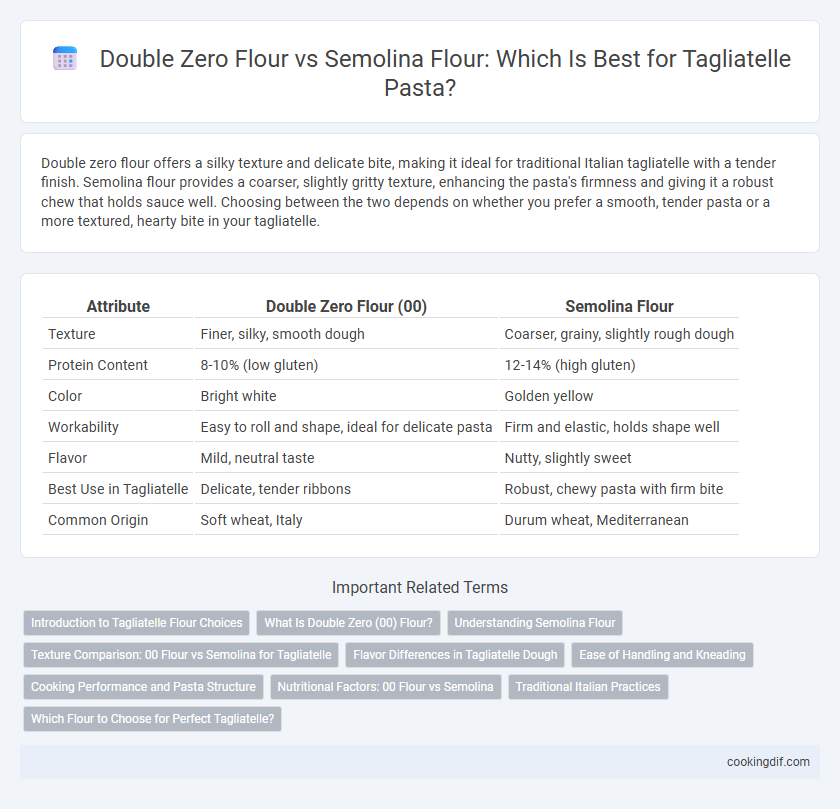Double zero flour offers a silky texture and delicate bite, making it ideal for traditional Italian tagliatelle with a tender finish. Semolina flour provides a coarser, slightly gritty texture, enhancing the pasta's firmness and giving it a robust chew that holds sauce well. Choosing between the two depends on whether you prefer a smooth, tender pasta or a more textured, hearty bite in your tagliatelle.
Table of Comparison
| Attribute | Double Zero Flour (00) | Semolina Flour |
|---|---|---|
| Texture | Finer, silky, smooth dough | Coarser, grainy, slightly rough dough |
| Protein Content | 8-10% (low gluten) | 12-14% (high gluten) |
| Color | Bright white | Golden yellow |
| Workability | Easy to roll and shape, ideal for delicate pasta | Firm and elastic, holds shape well |
| Flavor | Mild, neutral taste | Nutty, slightly sweet |
| Best Use in Tagliatelle | Delicate, tender ribbons | Robust, chewy pasta with firm bite |
| Common Origin | Soft wheat, Italy | Durum wheat, Mediterranean |
Introduction to Tagliatelle Flour Choices
Double zero flour, finely milled from soft wheat, provides a delicate texture and elasticity ideal for silky, tender tagliatelle. Semolina flour, coarser and derived from durum wheat, offers a slightly grainy texture and robust bite, enhancing pasta's firmness and flavor. Choosing between double zero and semolina flour depends on the desired mouthfeel and traditional regional preferences for authentic tagliatelle preparation.
What Is Double Zero (00) Flour?
Double zero (00) flour is an Italian-milled wheat flour characterized by its ultra-fine texture and low protein content, making it ideal for delicate pasta like tagliatelle due to its smooth dough and tender bite. Semolina flour, made from durum wheat, has a coarser texture and higher gluten content, resulting in a firmer, more textured pasta that holds shape well when cooked. Choosing 00 flour enhances tagliatelle's silkiness and elasticity, while semolina yields a chewier, rustic quality.
Understanding Semolina Flour
Semolina flour, milled from durum wheat, contains a high protein and gluten content that provides tagliatelle with a firm texture and excellent bite, making it a preferred choice for traditional pasta shapes. Its coarser granules help the pasta hold sauces better while resisting overcooking compared to softer flours like double zero, which yields a smoother but more delicate dough. Understanding semolina flour's gritty texture and strong gluten network is essential for crafting tagliatelle with authentic al dente characteristics and enhanced durability during cooking.
Texture Comparison: 00 Flour vs Semolina for Tagliatelle
Double zero (00) flour produces tagliatelle with a silky, delicate texture due to its finely milled, low-protein composition that allows for smooth dough elasticity. Semolina flour, derived from durum wheat, creates a coarser, slightly grainy texture, lending tagliatelle greater firmness and bite. The choice between 00 and semolina flour directly influences the pasta's mouthfeel, with 00 flour offering tenderness and semolina delivering a robust, al dente quality.
Flavor Differences in Tagliatelle Dough
Double zero flour produces a smooth, silky tagliatelle dough with a delicate, slightly sweet flavor that enhances subtle sauces. Semolina flour imparts a coarser texture and a nutty, earthy taste, adding depth to hearty, robust dishes. Choosing between these flours depends on whether a softer bite or a more pronounced, textured flavor is desired in the final pasta.
Ease of Handling and Kneading
Double zero flour offers a finer texture and lower protein content, making it easier to knead and shape for delicate tagliatelle dough. Semolina flour, with its coarser granules and higher gluten strength, provides more structure but requires more effort during kneading to achieve elasticity. Chefs often prefer double zero flour for smoother, more manageable dough handling in fresh pasta preparation.
Cooking Performance and Pasta Structure
Double zero flour, finely milled from soft wheat, produces tagliatelle with a silky, tender texture and smooth surface, allowing for quicker cooking and a delicate bite. Semolina flour, coarser and higher in protein from durum wheat, yields a firmer pasta structure with enhanced al dente resilience and better sauce adherence, but requires longer cooking times to soften. Tagliatelle made with a blend of double zero and semolina can achieve an optimal balance of elasticity, cooking performance, and robust texture.
Nutritional Factors: 00 Flour vs Semolina
Double zero flour for tagliatelle is finely milled from soft wheat, offering lower protein and gluten levels compared to semolina flour, which is derived from hard durum wheat. Semolina flour provides higher fiber, iron, and essential minerals, making it nutritionally richer and promoting better digestion. The choice between 00 and semolina influences the pasta's texture and its impact on blood sugar levels, with semolina offering a lower glycemic index due to its coarser grind.
Traditional Italian Practices
Traditional Italian tagliatelle often rely on double zero flour, prized for its fine texture and high gluten content that ensures a smooth, elastic dough ideal for hand-rolled pasta. Semolina flour, coarser and derived from durum wheat, provides a slightly grainier texture and firmer bite, favored in southern Italy for rustic pasta varieties but less common for delicate tagliatelle. Crafting authentic tagliatelle involves balancing the softness of double zero flour with the durability of semolina to achieve the perfect al dente texture revered in regional Italian cuisine.
Which Flour to Choose for Perfect Tagliatelle?
Choosing the right flour for perfect tagliatelle involves understanding the distinct qualities of double zero flour and semolina flour. Double zero flour, finely milled and soft, produces a silky, tender pasta ideal for delicate sauces, while semolina flour, coarser and higher in protein, lends a firm texture with a slight bite perfect for holding rich, hearty sauces. For authentic tagliatelle, blending both flours can balance smoothness and firmness, enhancing the pasta's elasticity and flavor absorption.
Double zero flour vs Semolina flour for tagliatelle Infographic

 cookingdif.com
cookingdif.com